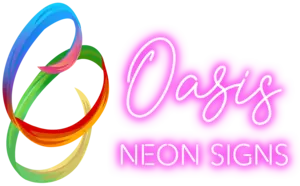
How Do Neon Signs Work?
Share
The cities of New York, Las Vegas, and Tokyo directly answer the question “how do neon signs work.” Cities come to life at night, thanks to neon lights. Neon signs have been used by businesses to draw clients for decades, ever since the technology was first introduced to the public on December 3, 1910, during the Paris Motor Show. Why do they still use neon signs today? These clever marketing strategies draw attention from pedestrians by lighting up the exterior doors and signage of theaters, motels, coffee shops, bars and etc.
Having said that, let's examine how neon lights work simple but powerful wonders in the visual settings of most businesses.
What Are Neon Signs?
Before learning how neon lights operate, let's start by learning the basics of neon signage. Neon, an odorless and colorless noble gas that is rarely found in Earth's atmosphere, is the source of the name for neon lights. Conventional neon lights give off a reddish-orange glow and include tiny amounts of neon gas. In addition, producers utilize various gases and chemicals to produce that range of hues.
How Are Neon Signs Made?
Gas discharge tubes, or more accurately, cold cathode fluorescent lamps, are the technical term for neon tubes (short: CCFL). Thus, it makes sense that the inert gas initially utilized in them led to the establishment of the vernacular moniker "neon". The term "new" (νέoς, néos) is Greek from history. Neon is no longer the only gas included in most current illuminated signs; instead, argon, or a combination of the two, is used.
Theoretically, every naturally existing noble gas will respond to electricity with a colorful discharge, which is why neon lights produce different colors as seen below:
- Xenon glows blue
- Krypton glows white or blue
- Helium glows orange-yellow, and
- Radioactive radon glows red
Neon colors, Classic Blue, and Classic Red are named after the bright red natural color of neon and the pastel purple, pink, or light blue natural color of argon. These days, the creation of neon signs involves the use of the last two gases.
How Do Neon Signs Work?

The technical details of the production and operation of neon shows how neon signs work physics. But in this section, let see how neon signs work:
- If you pay close attention, you can see that every neon sign is made up of one or more glass tubes that have been molded into a specific design.
- There are electrodes, one positive and one negative, on either side of the tube.
- There is a tiny quantity of neon gas inside the tube. As a noble gas, neon only reacts chemically when exposed to high energies, such as when it gets in touch with electricity. Otherwise, it does little more than drift through the tube.
- When the electrodes get an alternating current, the electricity produces enough energy to cause the neon atoms within the tube to split. Some become ions that are positively charged by losing electrons, and they move in the direction of the negative electrode.
- Attracted to the conductive electrode at the opposite end of the tube, the liberated electrons are negatively charged.
- The energy of the collisions between the neon atoms, ions, and electrons increases as they bounce around the tube.
- The ionized atoms emit a colored glow because they produce a photon, or particle of light when they recover their electrons and turn neutral once more, returning to their initial energy level. It is true that neon lights need electricity, but the neon atoms return to their typical inert condition when the sign's electrical feed is cut off.
Are Neon Signs Capable of Performing Various Lighting Functions?
The color of custom neon signs cannot be changed
Neon never glows blue or green, for example, when loaded with an electrical current; instead, it only produces a reddish-orange light. Upon passing electricity through the glass tube, the neon atoms within become energetic, resulting in a variation of red or orange.
Additional methods for creating multicolored lights are as follows:
- Using fluorescent powder or phosphor to cover the tubes, which, when activated, will light a particular color.
- Utilizing fluorescent lights in the tube that are colored
- Putting on tinted glass.
The color of LED neon signs can be changed.

LED neon signs can change color in two major ways.
1. Red-Green-Blue LED
Red, green, and blue (RGB) LED chips are the original and most popular alternative. This contains three tiny diodes, one for each color. The user can create a wide spectrum of colors by adjusting the strength of each red, green, or blue diode by connecting to an RGB controller.
2. LED digital
The LED chip in this example also makes use of red, green, and blue diodes. Nevertheless, a "driver chip" is also attached to the chip, enabling the user to regulate each LED separately. The controllers can create intricate patterns and designs since they have more sophisticated technology.
Dimming Options of Neon Light
Classical neon
If you are a business owner, you need to know the kind of neon lights used for your type of business. Using a dimmable neon transformer that is the right size based on the voltage of the current your sign requires you may dim a conventional neon sign. It is essential to select a transformer that is compatible with neon signs because they require high voltage and low current to operate. Commercial dimmer lamps are designed to control voltage alone; current flows through them. It could result in severe harm or a fire if one is used.
LED neon
LED neon signs can be dimmed in two diverse ways:
1. Digital or rotary dimmer with low voltage
These straightforward controllers lower the voltage that the power supply unit (PSU) supplies to the LED by being connected to the low-voltage side.
2. Dimmable power supply unit
This lowers the voltage inside the PSU when you attach it to a TRIAC or leading-edge rotary dimmer—the same type of dimmer you use to lower the lights within your dining room or living room. The lights then get dimmer because of the output voltage being lowered. For example, in a theater or retail center, this is an excellent alternative if you want to use a lighting system for the lighting. The user can decrease the LED to 0% with either of the settings, and the light will typically remain constant and flicker-free.
Neon Signs Performance Issues

Burn out
Sadly, burnout is a problem that neon signs tend to have somewhat frequently. The entire sign or a portion of it may eventually lose its glow, and one or more of the following causes may be to blame:
- Burnouts in the wires: Because neon signs work animation, the high-voltage connection that joins the neon glass tubes is typically the source of burnouts. They could burn out and stop glowing if they got too hot.
- Failing transformers: A neon sign is going to stop working if there is a problem with the transformer enabling the sign to illuminate.
- Gas tubes failing: If a glass tube's electrodes on each end aren't working correctly, parts of the tube may appear dull or not illuminate at all.
Heating
Neon signs operate on the principle that energy produced by atoms, electrons, and ions colliding inside the tubes occasionally manifests as both light and heat. But the neon sign shouldn't be so hot that it's dangerous to touch, even if it does emit heat—especially if it has very thin glass tubes. As a result, you shouldn't be concerned that neon signs could be harmful or result in burns. Rubber caps are used by many neon sign manufacturers to protect the conductors at any end of the glass tubing.
Power consumption
Although neon signs flash brightly, neon signs electricity consumptions are far less and are highly energy efficient. Most contemporary signs utilize between 60 and 100 watts of electricity, and most have a 240-volt transformer built in. Whereas fluorescent and light bulbs use a lot more power, an average LED neon light will use only 15%–20% of what a classic neon uses for similar work.
Lifespan
While many continue to work for far longer than that, neon signs are typically supposed to last eight to fifteen years. A sign's lifespan may be shortened by leaving it on for extended periods, and it may also be more susceptible to overheating or electrical surge damage. The lifespan of neon signs depends on factors like maintenance, installation quality, and environmental conditions, making proper care is essential to ensure longevity.
The Pros and Cons of Neon Signs

Considerations for and against selecting neon signs are listed in the table below.
Pros
- A lot of people love the cozy glow of neon over the more substantial LED light.
- Refilling the gases and replacing the glass tubes are the only maintenance requirements.
- There is no possibility of power surge damage.
Cons
- Neon sign requires a lot more energy to operate compared with LED vs Neon Sign
- May feel warm to the touch
- Risk of toxic gasses leaking
- Once in operation, there are no color changes
- Limited dimming options for the light.
Conclusion
Now that you are here, we want to believe that you now have a good knowledge on the question “how do neon signs work.” Neon lights come in a wide variety that you may use for signs in your home or place of business, thanks to scientific advancements over the years. You can find your ideal neon sign, whether it's for your house, wedding, or any other occasion.

